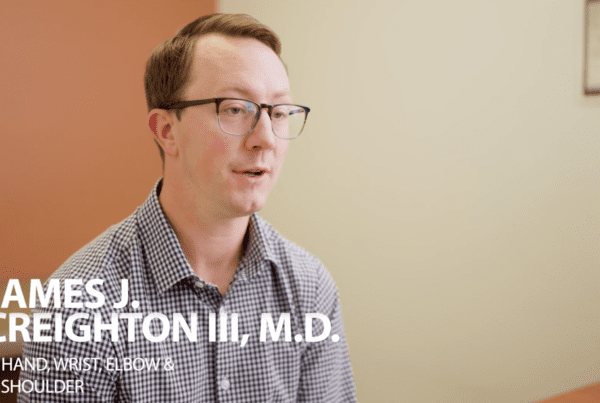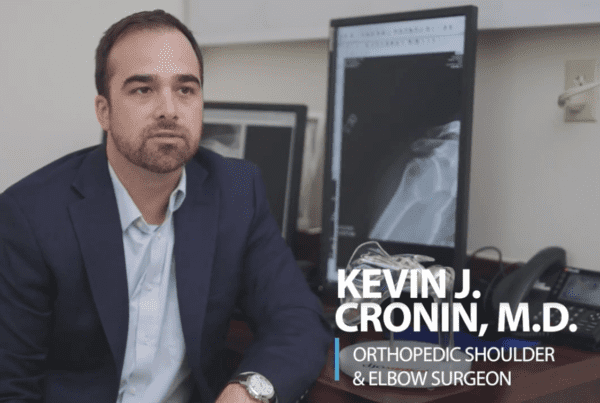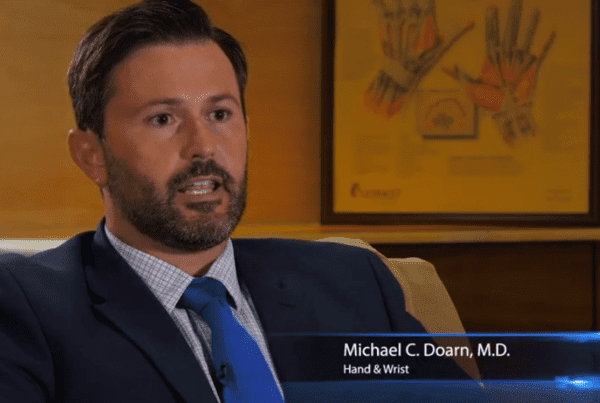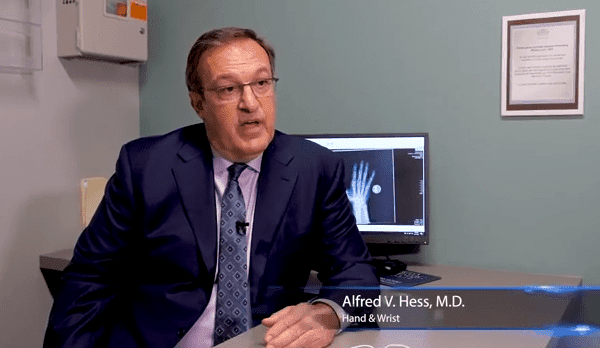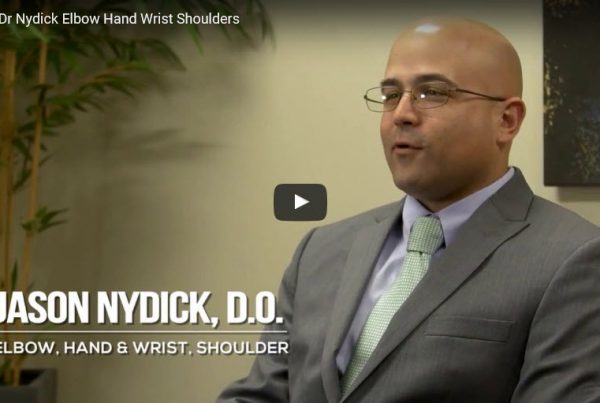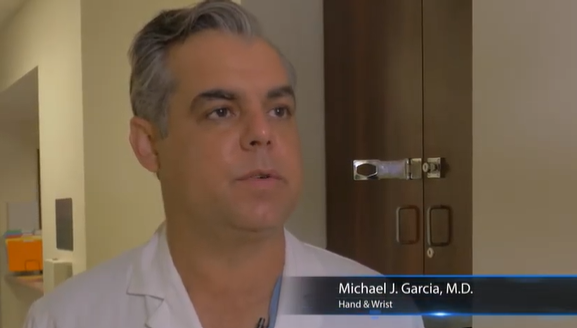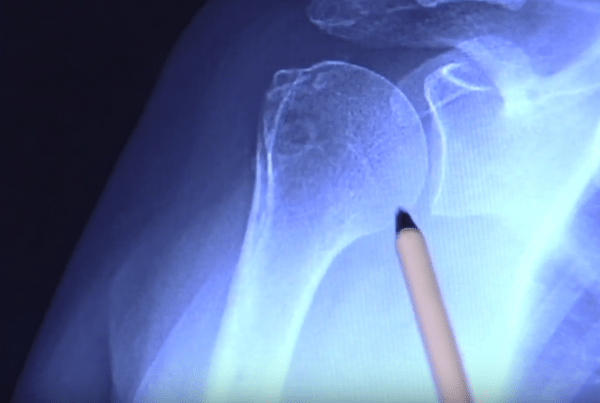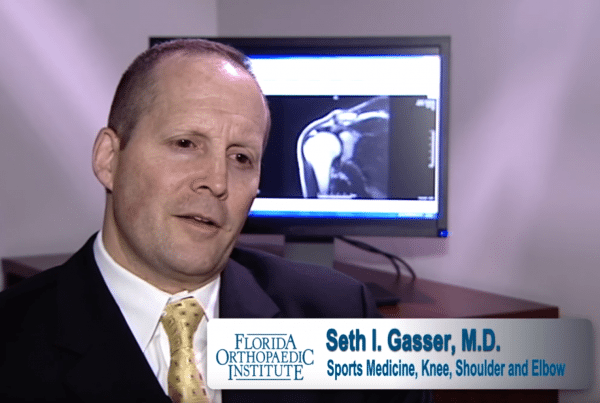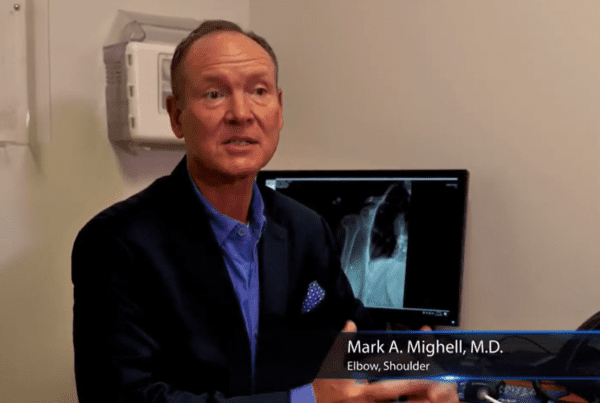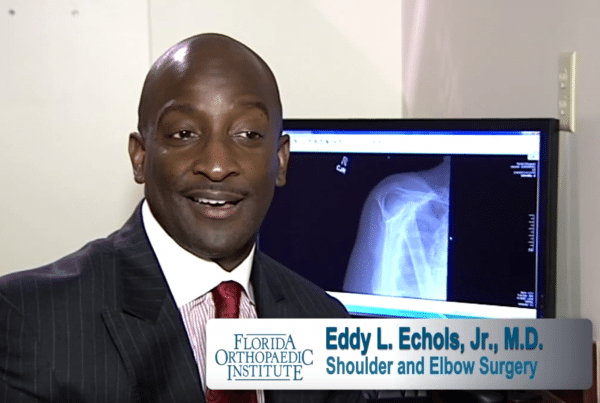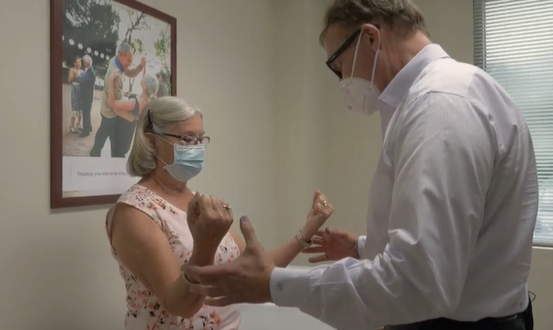Elbow Pain Treatment
The elbow is a joint that connects the upper arm’s humerus bone with the radius and ulna bones of the lower arm through a complex network of muscles, ligaments, and tendons. More than a simple hinge, the unique arrangement of these tissues also allows for rotation. Constant stress and motion can expose elbows to injuries and conditions that can cause alarming pain.
Treatment of injuries and diseases requires specialized knowledge. Our physicians are recognized as leaders in diagnosing and treating elbow problems. They provide a great base of shared knowledge with leading-edge surgery and treatment.
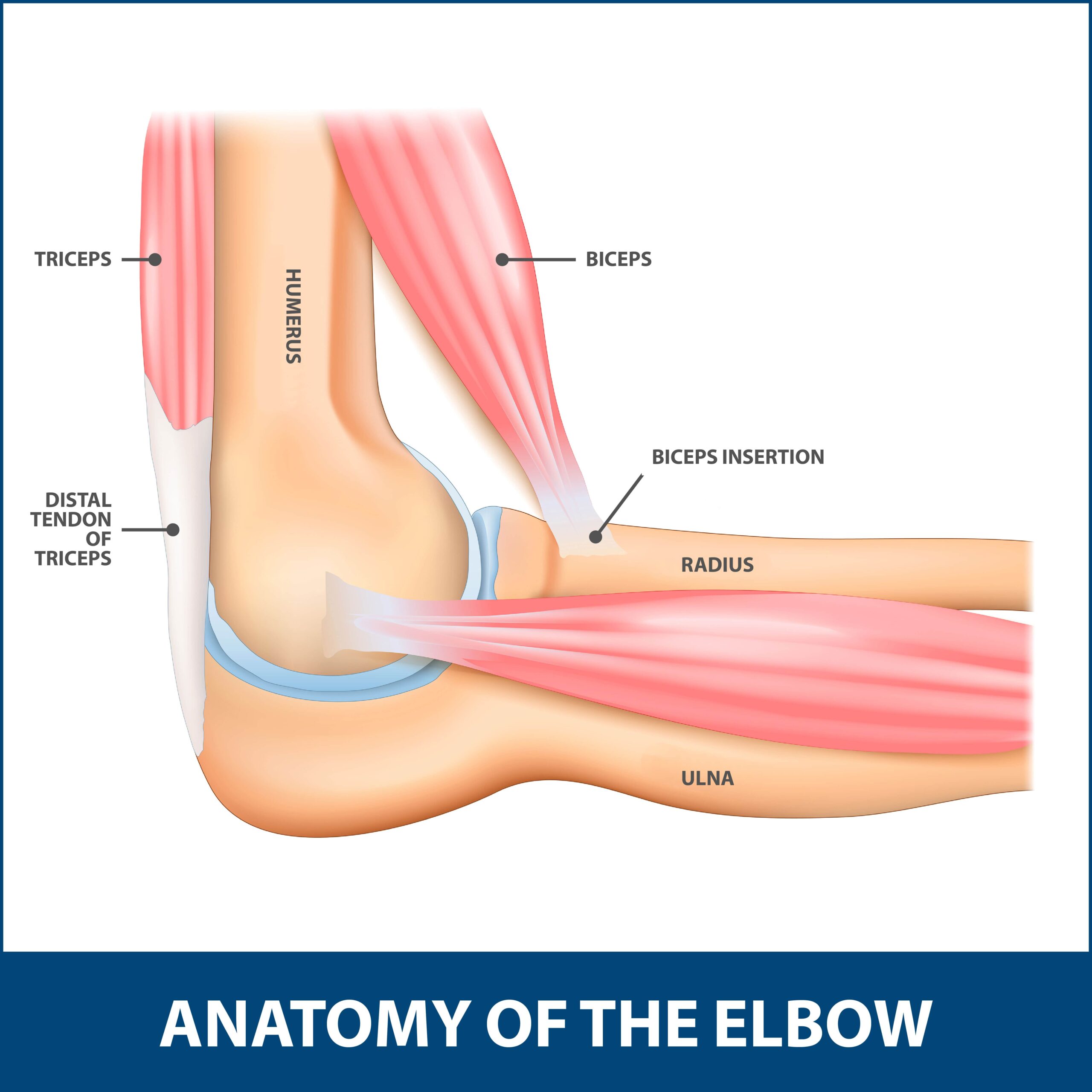
Causes Of Elbow Pain
A significant percentage of elbow pain cases result from overuse injuries. The problem can also occur due to a sudden (acute) event such as a fall, automobile accident, or direct contact during an athletic contest. Common elbow pain-producing conditions include:
- Bursitis.
- Osteoarthritis.
- Golfer’s elbow.
- Stress fractures.
- Sprains.
- Tendinitis.
- Tennis elbow.
- Nerve issues.
Injuries to neighboring features like the arm, fingers, wrists, and hand can also result in elbow discomfort.
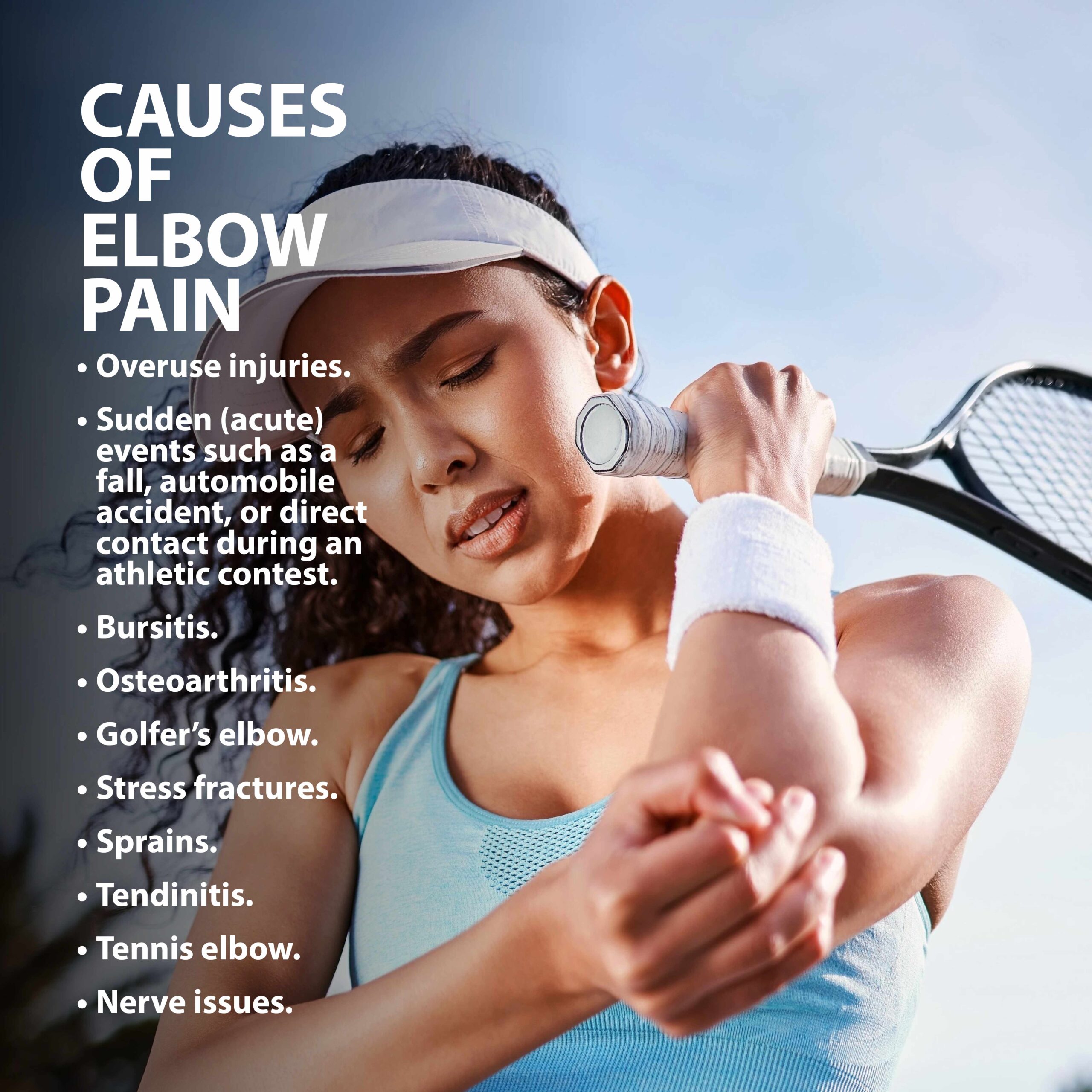
When Should You Consult Your Doctor?
Visit your doctor or one of our Orthopaedic Urgent Care locations if the pain is severe, movement-restricting, or accompanied by symptoms such as swelling or bruising.
You should also schedule an appointment with your FOI physician if your discomfort fails to improve using typical home care methods, if pain occurs when the elbow is idle, or if the injured region develops noticeable swelling or redness.
Potential Treatment Options
The therapeutic method your doctor prescribes will depend on several critical factors, including:
- The specific underlying injury.
- The issue’s severity.
- Your age.
- Your general health.
- Injuries to neighboring physical features.
- Your current physical condition and future fitness goals.
Mild matters are often first treated using home care methods, such as:
- The RICE Protocol – RICE is an abbreviation for rest, ice, compression, and elevation. Rest the injured elbow as much as possible, apply ice to the injured area to ease pain and reduce swelling, compress the injured joint to prevent unnecessary movement and further damage, and elevate your elbow above the heart, which increases blood flow to the damaged area and quickens the healing process.
- Pain-Relieving Medications – Your doctor might suggest using common over-the-counter inflammation-reducing or pain-relieving medications. If your pain is more intense or motion-limiting, your physician may prescribe prescription pain relievers.
Moderate to severe injuries may benefit from specialized exercises (physical therapy) geared toward helping your injured elbow regain strength and motion, or surgery to repair or replace damaged components.
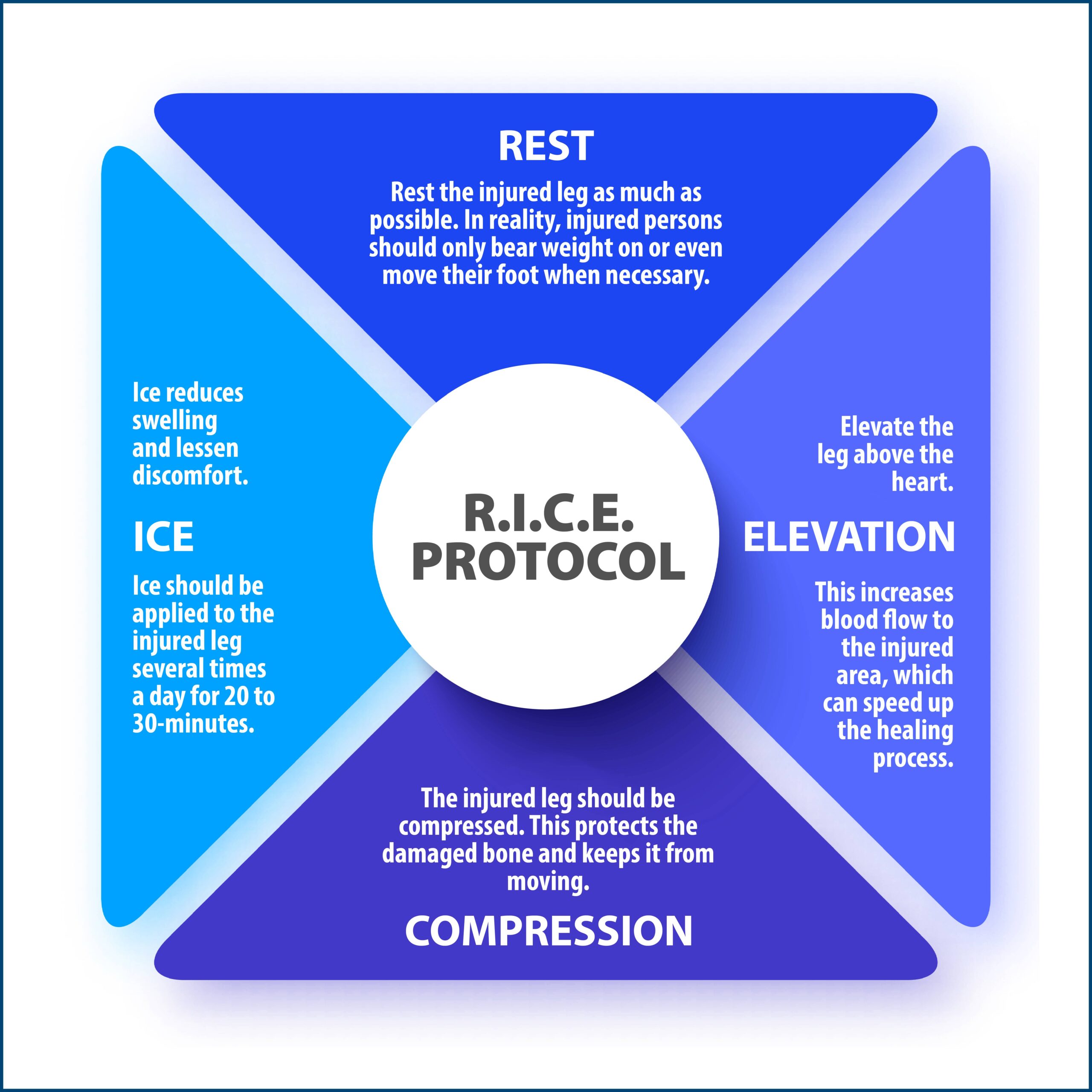
Recovery from Elbow Pain
Recovery times will vary depending on your specific injury, how serious the problem was, the treatment used to address it, and how favorably you respond to the therapy.
Prevention of Elbow Pain
It is not always possible to prevent or anticipate accidents such as falls. You can lower your risk of developing elbow pain by:
- Practicing Good Posture – You might think posture only impacts your neck, back, and legs. Slouching while you walk and sitting in awkward positions can also harm your elbows. Always stand up straight and never sit hunched over while relaxing or performing activities like computer work.
- A Nutritious Diet – Foods like vegetables, fruits, lean meats, and whole grains contain essential nutrients that keep elbow components strong and decrease injury-causing inflammation.
- Keeping Muscles and Bones Loose – You can prevent some injuries by simply stretching and loosening your muscles and soft tissues before participating in athletic competitions or physical labor.
- Getting Enough Sleep – Adequate rest is crucial in enabling your body time to heal correctly. Active adults should get anywhere from seven to nine hours each evening.
ELBOW INJURIES IN THROWING ATHLETES
Overhand throwing places extremely high stress on the elbow and when repeated, it leads to serious overuse injuries, especially in throwing athletes like baseball pitchers.
Common throwing injuries of the elbow include flexor tendinitis, ulnar collateral ligament (UCL) injury, valgus extension overload (VEO), olecranon stress fractures and ulnar neuritis.
To learn more about throwing injuries of the elbow, nonsurgical treatments and Tommy John elbow surgery for UCL injuries, click on the link below.
Learn more about Elbow Injuries in Throwing AthletesGolfer’s Elbow
Golfer’s elbow (medial epicondylitis) is a condition that produces pain where the tendons of your forearm attach to the bump on the inside of your elbow. The pain sometimes spreads into your forearm and wrist.
Golfer’s elbow is similar to tennis elbow, which occurs on the outside of the elbow. Golfer’s elbow is not limited to golfers. Tennis players and others who repeatedly use their wrists or clench their fingers also can develop golfer’s elbow.
The majority of patients that have golfer’s elbow don’t play golf or tennis. Most of the time, it is an overuse injury. Typing on the computer or repetitive activities at work can overwork the tendons and create small tears, causing the pain.
Golfer’s elbow symptoms occur on the inside of the elbow and can happen slowly or quickly. The elbow may feel stiff and hurt when making a fist. Some people feel weakness and tingling in the arm and fingers. Pain may get worse when swinging a racket or golf club, shaking hands, squeezing a ball, turning a doorknob, lifting weights, or flexing the wrist.
Learn more about Golfer's Elbow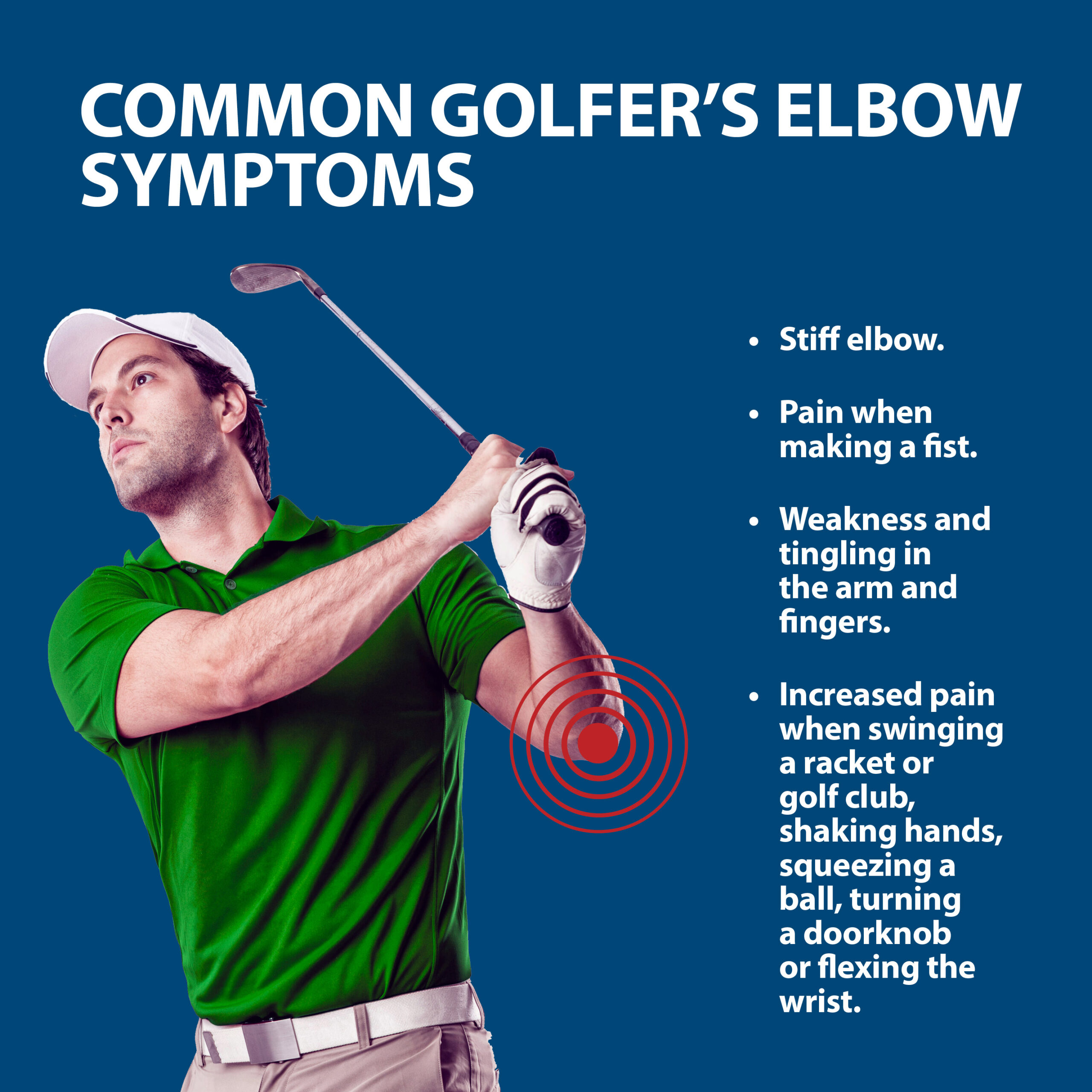
OLECRANON STRESS FRACTURES
A break in the bony “tip” of the elbow is called an olecranon fracture. The olecranon is the pointy segment of bone and part of the ulna. It is one of the three bones that come together to form the elbow joint.
Since the olecranon is positioned directly under the skin of the elbow, it does not have much protection from either muscles or other soft tissues. If you experience a direct blow to the elbow or fall on an outstretched arm, it can break easily. An olecranon fracture can be very painful and make elbow motion difficult or impossible. Olecranon stress fractures can occur from extreme abuse and overuse like athletes who throw frequently.
Tennis Elbow
Tennis elbow (lateral epicondylitis) is caused by inflammation of the tendons that attach the muscle in the forearm (extensor carpi radialis brevis) to the outer bony bumps at the bottom of the long bone of the arm (humerus) called the lateral epicondyle.
Not limited to tennis players, tennis elbow can occur in anyone who strains the tendons of the forearm. In tennis, maneuvers like a one-handed backhand with poor form or technique, a late forehand swing resulting in bending the wrist significantly or turning and snapping the wrist while serving with full power can lead to tennis elbow.
Tennis elbow can also occur from repetitive movements of the wrist. These motions can include tennis, hedge clipping, excessive use of a hammer or screwdriver, painting, or any activity that requires constant gripping or squeezing.
Some tennis elbow symptoms and signs include tenderness on the outside of the elbow, soreness of the forearm muscles, elbow pain when grasping or holding an object, and morning stiffness of the elbow with persistent aching.
Learn more about Tennis Elbow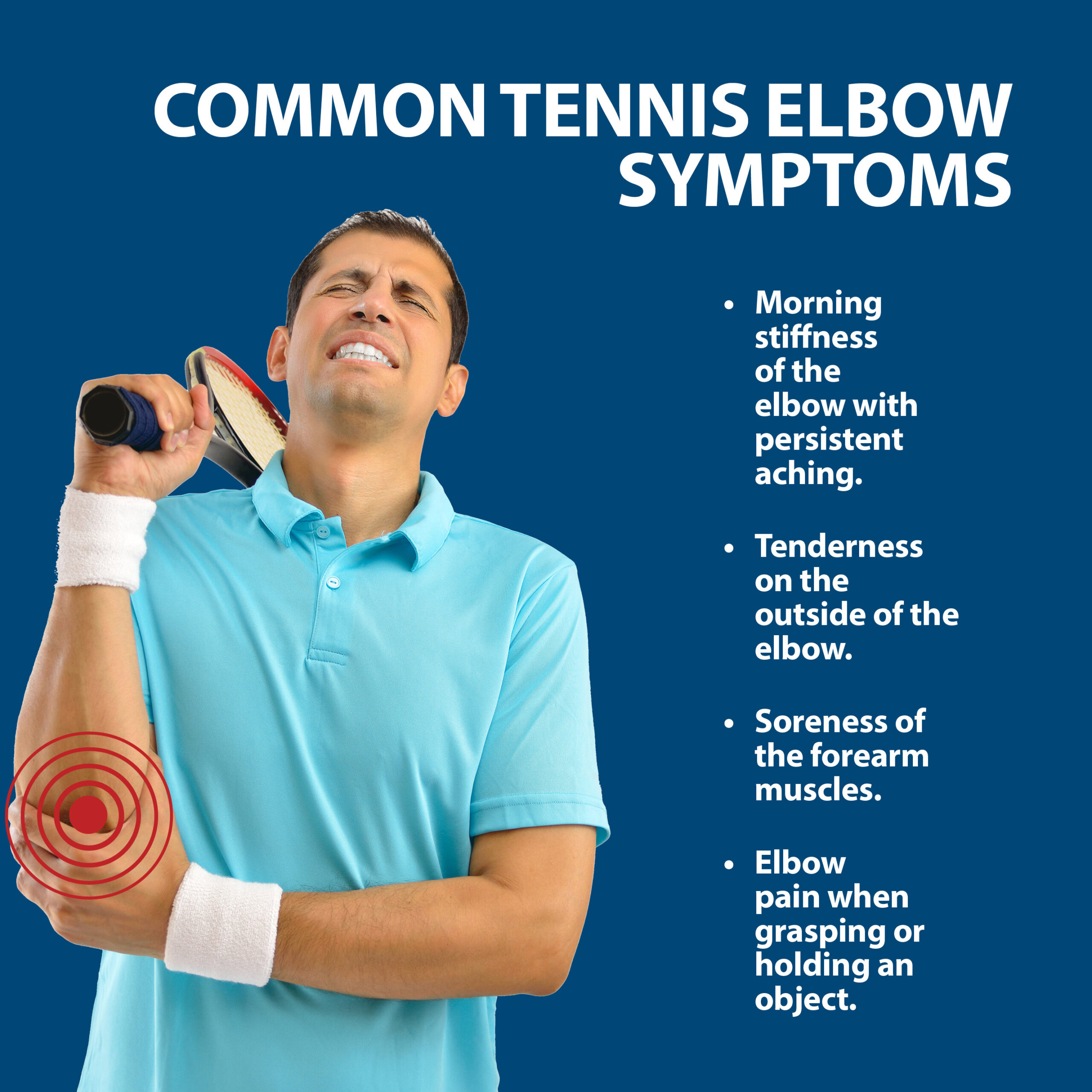
ULNAR COLLATERAL LIGAMENT (UCL) INJURIES
Ulnar collateral ligament injury of the elbow is when the ligament on the inner side of the elbow is sprained or torn. The ulnar collateral ligament (UCL) keeps the upper arm bone (humerus) and the one of the forearm bones (ulna) in place.
Ulnar collateral ligament (UCL) injuries can occur from repetitive stress to the inside of the elbow. Because of the popularity of overhead sports such as volleyball and baseball, UCL injuries are becoming more common. Often referred to as a “Tommy John” injury, after the famous baseball pitcher who underwent the first surgery for a UCL injury in 1974.
Learn more about Ulnar collateral ligament (UCL) injuriesVALGUS EXTENSION OVERLOAD (VEO)
Valgus extension overload is a common injury among throwing athletes and is also known as ‘Pitcher’s Elbow’. Repetitive throwing, such as in baseball pitching, causes massive stress to the elbow.
When the olecranon and humerus bones are twisted during throwing, it forces them together. This can cause the protective cartilage on the olecranon to be gradually worn away.
Throwers with Valgus Extension Overload typically have pain at the tip of the elbow in the deceleration and follow-through phases of throwing. There may be a sharp pain or a snapping sensation as they release the ball. Pain typically increases over time and only happens during throwing and not in other daily activities. Other symptoms can accompany the pain including numbness, tingling and loss of velocity or control.
Learn more about Valgus Extension Overload (VEO)ARTHROSCOPIC DEBRIDEMENT OF THE ELBOW
Performed under local anesthesia with sedation or general anesthesia, this outpatient procedure allows the surgeon to examine the cartilage, bones, ligaments and tendons of the elbow for damage or disorders. A small camera, called an arthroscope, is inserted into the elbow through a very small incision. The camera gives the surgeon with a close-up view of the entire procedure on a monitor.
Learn more about Arthroscopic DebridementAspiration of the Olecranon Bursa
The olecranon bursa is located at the back of the elbow (the olecranon) between the skin and the bone. It is a small, thin fluid-filled sac that provides cushioning to the bones, tendons and ligaments of the joint. If the bursa becomes irritated or inflamed, fluid begins to accumulate within it, leading to the development of olecranon bursitis.
Aspiration of the olecranon bursa relieves pain and swelling in the elbow caused by bursitis, or inflammation of the bursa.
This nonsurgical procedure removes the fluid from the bursa with a needle. An aspiration can provide relief of symptoms and helps the doctor to determine exactly what is causing pain around the elbow.
Learn more about Aspiration of the Olecranon BursaCubital Tunnel Syndrome
Cubital tunnel syndrome is when the ulnar nerve (also known as the “funny bone”) is pressed or stretched, causing numbness or tingling in the ring and small fingers, pain in the forearm, and weakness in the hand.
Common symptoms include numbness and tingling in the hand or ring and little finger, especially when the elbow is bent, numbness and tingling at night, hand pain, weak grip in the affected arm and hand, a decrease in finger coordination, and aching pain on the inside of the elbow.
Learn more about Cubital Tunnel SyndromeELBOW BURSITIS
A common condition that causes pain and swelling in the back of the elbow, elbow bursitis is an inflammation of the olecranon bursa. The olecranon bursa is a thin, fluid-filled sac located at the boney tip of the elbow (the olecranon).
Also called olecranon bursitis, elbow bursitis typically responds to simple non-surgical treatments like medicine and self-care at home. Infected bursae or chronic bursitis usually requires more invasive treatments.
Learn more about Elbow BursitisGROWTH PLATE INJURIES OF THE ELBOW
Growth plate injuries of the elbow are breaks (fractures) on the end of the upper arm bone (humerus) or lower arm bone (radius or ulna) where they come together to form the elbow joint. Growth plates are areas of cartilage at the end of a bone where new bone is made.
In adults, these areas close as the bone quits growing. These areas remains open In children and teenagers. Growth plates are one of the weakest spots in the upper arm because they are open zones of soft cartilage, and weaker than the attaching ligaments and muscles.
If not treated right away, a fracture in the growth plate can cause slow growth or problems with the shape of the bone. To help reduce the risk of a mild injury becoming more severe, early detection is very important.
LEARN MORE ABOUT GROWTH PLATE INJURIES OF THE ELBOWLITTLE LEAGUER’S ELBOW (MEDIAL APOPHYSITIS)
Little Leaguer’s Elbow (Medial Apophysitis) is an injury caused when repetitive throwing creates an excessively strong pull on the tendons and ligaments of the elbow. It is the most common injury affecting young baseball pitchers. It can occur when improper throwing techniques are used, such as throwing the ball too hard or too often.
Symptoms can include swelling and pain on the inside (medial) part of the elbow. Pain may limit arm motion. Little Leaguer’s Elbow can be serious if it becomes aggravated, disrupting normal bone growth.
LITTLE LEAGUER'S ELBOW (MEDIAL APOPHYSITIS)HYPEREXTENSION INJURY OF THE ELBOW
Hyperextension injury of the elbow happens when you extend your elbow back farther than it’s supposed to go. When the elbow joint moves outside its normal range of motion, it damages the bones and soft tissues in your joint. Hyperextension can dislocate or even fracture your elbow.
This injury mainly occurs to those who play contact sports or engage in other strenuous physical activities. It also happens during a trip or fall when the elbow is reached out to cushion a fall.
This injury can be painful and take several weeks to heal.
LEARN MORE ABOUT HYPEREXTENSION INJURY OF THE ELBOWTRICEPS TENDONITIS
Triceps tendonitis is an injury or inflammation in the triceps tendon (the thick band of connective tissue) that connects muscle on the back of the arm (triceps) to the elbow bone. The triceps muscle straightens the arm back out after it has been bent.
Also known as tricep tendonitis, even at rest it can cause tricep pain. It can also cause elbow tightness and pain, and triceps tenderness when touched.
Triceps tendonitis is usually caused by overuse or injury during activities that involve repeated extending of the elbow.
LEARN MORE ABOUT TRICEPS TENDONITISRADIAL TUNNEL SYNDROME (ENTRAPMENT OF THE RADIAL NERVE)
This condition involves the radial nerve in your elbow. The radial nerve passes down your arm to your hand. Its branches travel into your thumb, forefinger, and middle finger. With this condition, your radial nerve is compressed, stretched, or irritated. Radial tunnel release surgery treats radial tunnel syndrome by giving the nerve more room.
LEARN MORE ABOUT RADIAL TUNNEL SYNDROMEAreas of Focus
- Elbow
- Arthroscopic Debridement of the Elbow
- Aspiration of the Olecranon Bursa - Fluid In Elbow
- Cubital Tunnel Syndrome
- Elbow Bursitis
- Elbow Injuries & Inner Elbow Pain in Throwing Athletes
- Golfer's Elbow
- Growth Plate Injuries Of The Elbow
- Hyperextension Injury of the Elbow
- LITTLE LEAGUER'S ELBOW (MEDIAL APOPHYSITIS)
- Olecranon Stress Fractures
- Radial Tunnel Syndrome (Entrapment of the Radial Nerve)
- Tennis Elbow Treatment
- Tricep Pain & Tendonitis
- UCL (Ulnar Collateral Ligament) Injuries
- Valgus Extension Overload
The following Florida Orthopaedic Institute physicians specialize in Elbows:
Shoulder & Elbow Specialty
Florida Orthopaedic Institute’s fellowship-trained Shoulder & Elbow Specialists talk about shoulder and elbow injuries and the advancing technology available to treat them, thanks, in part, to ongoing research by Florida Orthopaedic Institute’s own surgeons.
Common Elbow Conditions
- Cubital Tunnel Syndrome
- Elbow Bursitis
- Golfer’s Elbow (Medical Epicondylitis)
- Growth Plate Injuries
- Hyperextension Injury
- Inflammation of the Biceps Tendon
- Medial Apophysitis
- Medical Ulner Collateral Ligament Injury
- Osteochondritis Dissecans
- Overuse Injuries
- Radial Tunnel Syndrome (Entrapment of the Radial Nerve)
- Tennis Elbow (Lateral Epicondylitis)
- Throwing Injuries
- Triceps Tendonitis
Common Elbow Procedures
- Arthroscopic Debridement of the Elbow
- Aspiration of the Olecranon Bursa
- Cubital Tunnel Release at the Elbow
- Medial Epicondylectomy
- Tommy John Surgery (Medial Ulnar Collateral Ligament Reconstruction)
- Radial Tunnel Release at the Elbow
- Ulnar Nerve Transposition at the Elbow
Specialties
- AC Joint Injuries
- Achilles Tendinitis - Achilles Insertional Calcific Tendinopathy (ACIT)
- Achilles Tendon Rupture
- Achilles Tendonitis
- ACL Injuries
- Ankle Fracture Surgery
- Ankle Fractures (Broken Ankle)
- Ankle Fusion Surgery
- Anterior Cervical Corpectomy & Discectomy
- Arthroscopic Articular Cartilage Repair
- Arthroscopic Chondroplasty
- Arthroscopic Debridement of the Elbow
- Arthroscopy Of the Ankle
- Articular Cartilage Restoration
- Artificial Disk Replacement (ADR)
- Aspiration of the Olecranon Bursa - Fluid In Elbow
- Atraumatic Shoulder Instability
- Avascular Necrosis (Osteonecrosis)
- Bankart Repair
- Basal Joint Surgery
- Bicep Tendon Tear
- Bicep Tenodesis
- Bone Cement Injection
- Bone Growth Stimulation
- Bone Health Clinic
- Broken Collarbone
- Bunions
- Bursitis of the Shoulder (Subacromial Bursitis)
- Calcific Tendinitis of the Shoulder
- Carpal Tunnel Syndrome
- Charcot Joint
- Chiropractic
- Clavicle Fractures
- Colles’ Fractures (Broken Wrist)
- Common Foot Fractures in Athletes
- Community Outreach
- Cubital Tunnel Syndrome
- De Quervain's Tenosynovitis
- Deep Thigh Bruising
- Degenerative Disk Disease
- Diffuse Idiopathic Skeletal Hyperostosis (DISH)
- Discectomy
- Discitis Treatment & Information
- Dislocated Shoulder
- Dupuytren’s Disease
- Elbow
- Elbow Bursitis
- Elbow Injuries & Inner Elbow Pain in Throwing Athletes
- Epidural Injections for Spinal Pain
- Finger Dislocation
- Flexor Tendonitis
- Foot Stress Fractures
- Foot, Ankle & Lower Leg
- Foraminotomy
- Fractured Fingers
- Fractures Of The Shoulder Blade (Scapula)
- Fractures Of The Tibial Spine
- Functional Nerve Transfers of The Hand
- Ganglion Cysts
- General Orthopedics
- Glenoid Labrum Tear
- Golfer's Elbow
- Groin Strains and Pulls
- Growth Plate Injuries Of The Elbow
- Hallux Rigidus Surgery - Cheilectomy
- Hammer Toe
- Hamstring Injuries
- Hand & Finger Replantation
- Hand & Wrist
- Hand Nerve Decompression
- Hand Skin Grafts
- Hand, Wrist, Elbow & Shoulder
- Heat Injury/Heat Prostration
- High Ankle Sprain (Syndesmosis Ligament Injury)
- Hip & Thigh
- Hip Arthroscopy
- Hip Dislocation
- Hip Flexor Strains
- Hip Fractures
- Hip Hemiarthroplasty
- Hip Impingement Labral Tears
- Hip Muscle Strains
- Hip Pointers and Trochanteric Bursitis
- Hyperextension Injury of the Elbow
- Iliopsoas Tenotomy
- Iliotibial Band Syndrome
- Impingement Syndrome of the Shoulder
- Interlaminar Implants
- Interlaminar Lumbar Instrumental Fusion: ILIF
- Interventional Pain Management
- Interventional Spine
- Intraarticular Calcaneal Fracture
- Joint Replacement
- Knee & Leg
- Kyphoplasty (Balloon Vertebroplasty)
- Kyphosis
- Labral Tears Of The Hip (Acetabular Labrum Tears)
- Laminectomy: Decompression Surgery
- Lateral Collateral Ligament (LCL) Injuries
- Lisfranc Injuries
- Little League Shoulder
- LITTLE LEAGUER'S ELBOW (MEDIAL APOPHYSITIS)
- Lumbar Epidural Steroid Injection
- Lumbar Interbody Fusion (IBF)
- MACI
- Mallet, Hammer & Claw Toes
- Medial Collateral Ligament Injuries
- Meniscus Tears
- Metatarsalgia
- Minimally Invasive Spine Surgery
- Morton’s Neuroma
- Muscle Spasms
- Muscle Strains of The Calf
- Nerve Pain
- Neuromas (Foot)
- Neurosurgery
- Olecranon Stress Fractures
- Orthopaedic Total Wellness
- Orthopaedic Trauma
- Orthopedic Physician Or A Podiatrist? Definition of a Podiatrist
- Osteoarthritis of the Hip
- Osteoporosis
- Outpatient Spine Surgery
- Partial Knee Replacement
- Patellar Fracture
- Pelvic Ring Fractures
- Peripheral Nerve Surgery (Hand) Revision
- Pinched Nerve
- Piriformis Syndrome
- Piriformis Syndrome
- Plantar Fasciitis
- Plastic Surgery
- Podiatry
- Primary Care Sports Medicine
- Quadriceps Tendon Tear
- Radial Tunnel Syndrome (Entrapment of the Radial Nerve)
- Revascularization of the Hand
- Reverse Total Shoulder Replacement
- Rheumatoid Arthritis (RA) of the Shoulder
- Rheumatoid Arthritis Of The Hand
- Robotics
- Rotator Cuff Tears
- Runner's Knee
- Sacroiliac Joint Pain
- Sciatica
- Scoliosis
- Senior Strong
- Shin Splints
- Shoulder
- Shoulder Arthritis
- Shoulder Arthroscopy
- Shoulder Injury: Pain In The Overhead Athlete
- Shoulder Replacement
- Shoulder Separations
- Shoulder Socket Fracture (Glenoid Fracture)
- SLAP Tears & Repairs
- Spinal Fusion
- Spine
- Spondylolisthesis and Spondylolysis
- Sports Foot Injuries
- Sports Hernias (Athletic Pubalgia)
- Sports Medicine
- Sports Wrist and Hand Injuries
- Sprained Ankle
- Sprained Wrist Symptoms and Treatment
- Subacromial Decompression
- Sudden (Acute) Finger, Hand & Wrist Injuries
- Targeted Muscle Reinnervation (TMR)
- Tendon Transfers of The Hand
- Tennis Elbow Treatment
- Thigh Fractures
- Thigh Muscle Strains
- Thumb Ulnar Collateral Ligament Injuries
- Total Ankle Replacement
- Total Hip Arthroplasty
- Total Hip Replacement - Anterior Approach
- Total Knee Replacement Surgery
- Trapezius Strain (Muscle Strain of The Upper Back)
- Traumatic Shoulder Instability
- Tricep Pain & Tendonitis
- Trigger Finger
- Turf Toe
- UCL (Ulnar Collateral Ligament) Injuries
- Ulnar Neuritis
- Valgus Extension Overload
- Vertebroplasty
- WALANT (Wide Awake Local Anesthesia No Tourniquet)
- Whiplash and Whiplash Associated Disorder (WAD)
- Wound Care
- Wrist Arthroscopy
- Wrist Fractures
- Wrist Tendonitis
Services
- Physical Medicine & Rehabilitation
- Physical Therapy
- Primary Care Sports Medicine
- PROMs (Patient-Reported Outcome Measures)
- Same-Day Orthopaedic Appointments Now Available
- Sports Medicine
- Sports-Related Concussion Treatment
- Telehealth Page
- Telemedicine
- Workers' Compensation
- Workers' Compensation Dispensary
- X-Ray


